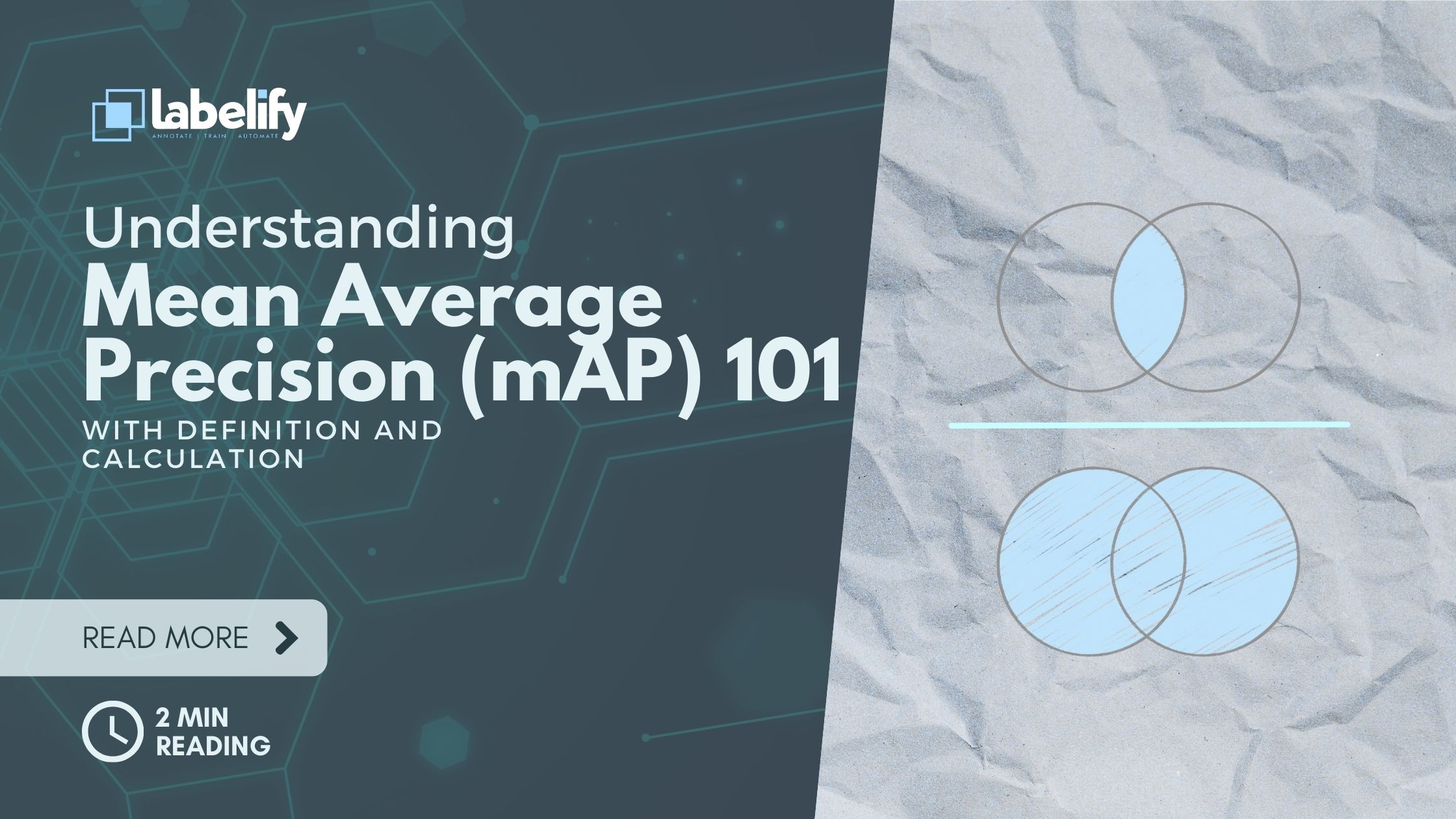Mean Average Precision (mAP) is a crucial metric for evaluating object detection models, measuring their performance and accuracy. By calculating the mean of average precision values, mAP provides a comprehensive assessment of a model's capability.
It incorporates sub-metrics such as Confusion Matrix, Intersection over Union (IoU), Recall, and Precision, and is widely used for benchmark challenges like Pascal, VOC, and COCO.
This article delves into the calculation of mAP, the importance of the precision-recall curve, and other related metrics, empowering readers with a deep understanding of object detection evaluation.
Key Takeaways
- Mean Average Precision (mAP) is a metric used to evaluate object detection models.
- mAP calculates the mean of average precision (AP) values, which are calculated over recall values from 0 to 1.
- Precision-Recall curve is important as it plots precision and recall values against the model's confidence score threshold, providing a better idea of model accuracy.
- mAP is commonly used to analyze the performance of object detection and segmentation systems, and it considers both false positives (FP) and false negatives (FN).
Calculation of Map
The calculation of mAP involves determining the average precision (AP) for each class and then averaging them together. To calculate AP, we start by generating prediction scores for each instance in the dataset. These scores represent the confidence level of the model's prediction.
Next, we convert these scores to class labels by applying a threshold. This allows us to determine whether a prediction is considered positive or negative. Once we have the prediction labels, we can calculate the confusion matrix, which provides information about true positives, false positives, true negatives, and false negatives.
From this matrix, we compute precision and recall values. Finally, using a weighted mean calculation for AP, we obtain the average precision for each class.
This process allows us to evaluate the model's performance in terms of precision and recall, providing valuable insights for object detection tasks.
Precision-Recall Curve and Its Importance
The Precision-Recall curve is a crucial tool in evaluating the performance of object detection models. It plots precision and recall values against the model's confidence score threshold, providing valuable insights into the model's accuracy. Precision measures the model's correct predictions, while recall measures if all predictions are made. However, these metrics alone have limitations. The Precision-Recall curve overcomes these limitations by maximizing the effect of both metrics, giving a better understanding of the model's accuracy. It allows for a trade-off between precision and recall, depending on the problem at hand. By finding the optimal balance between precision and recall, we can maximize model accuracy. The following table provides an example of a Precision-Recall curve:
| Confidence Score Threshold | Precision | Recall |
|---|---|---|
| 0.1 | 0.90 | 0.95 |
| 0.3 | 0.85 | 0.92 |
| 0.5 | 0.80 | 0.88 |
| 0.7 | 0.75 | 0.82 |
| 0.9 | 0.70 | 0.75 |
Map for Object Detection
Moving forward in the discussion, let's delve into the concept of Mean Average Precision (mAP) for object detection.
mAP plays a crucial role in benchmark challenges such as Pascal, VOC, COCO, and more. It acts as a powerful tool to analyze the performance of object detection and segmentation systems.
One important component of mAP is Intersection over Union (IoU) for object detection. IoU measures the overlap between the predicted bounding box and the ground truth bounding box.
By considering both false positives (FP) and false negatives (FN), mAP provides a comprehensive evaluation of object detection models. This metric allows researchers and practitioners in the field to assess the trade-off between precision and recall, making it suitable for most detection applications.
Other Metrics Related to Map
Additionally, there are several other metrics that are closely related to mAP and complement its evaluation of object detection models. Two such metrics are the F1 Score and AUC (Area Under the Curve). The F1 Score is a widely used metric that calculates the balance between precision and recall, providing a single value that represents the model's overall performance. It finds the optimal confidence score threshold where the F1 Score is highest, giving a measure of how well the model balances between precision and recall. On the other hand, AUC covers the area underneath the precision-recall curve, providing an overall measure of model performance. It considers the trade-off between precision and recall at different confidence score thresholds. Both F1 Score and AUC complement mAP in evaluating object detection models, providing additional insights into their performance and allowing for a more comprehensive evaluation.
| Metric | Description |
|---|---|
| F1 Score | Calculates the balance between precision and recall, providing an overall measure of model performance. |
| AUC | Covers the area underneath the precision-recall curve, giving a comprehensive measure of model performance. |
These metrics, along with mAP, form a powerful toolkit for evaluating detection models, allowing for a more nuanced understanding of their strengths and weaknesses. By considering multiple metrics, researchers and practitioners can make informed decisions and improve the performance of object detection systems. Liberation from the limitations of traditional evaluation methods is crucial for pushing the boundaries of computer vision and advancing the field.
Conclusion
To summarize, understanding the concept of mean average precision (mAP) and its related metrics is essential for evaluating the performance of object detection models accurately.
However, it is important to acknowledge the limitations of mAP in object detection models. While mAP provides a comprehensive evaluation by considering both precision and recall, it may not capture the nuances of specific detection tasks or address the inherent challenges in real-world scenarios.
Future developments and advancements in mAP calculation and interpretation should focus on addressing these limitations. This can include exploring novel approaches to handle class imbalance, handling multiple object instances, and incorporating contextual information.
Additionally, advancements in deep learning techniques, such as attention mechanisms and hierarchical modeling, may further enhance the accuracy and robustness of mAP measurements. By continuously pushing the boundaries of mAP, we can strive for more reliable and efficient object detection models that empower us to unlock new possibilities in various domains.
Frequently Asked Questions
How Is Map Different From Accuracy in Object Detection Models?
Accuracy is a commonly used metric in object detection models, but it has limitations. Unlike accuracy, mAP takes into account both false positives and false negatives, providing a more comprehensive evaluation of model performance.
mAP also considers the trade-off between precision and recall, making it suitable for most detection applications. In comparison, accuracy only measures the percentage of correct predictions, without considering the specific challenges of object detection.
Therefore, mAP is a more effective evaluation metric for object detection models.
Can Map Be Used to Evaluate Models for Other Tasks Besides Object Detection?
mAP, or Mean Average Precision, is a widely used metric for evaluating object detection models. However, its applicability extends beyond just object detection.
While mAP is primarily used in the context of computer vision tasks, such as object detection and segmentation, it can also be adapted for other tasks like text classification and recommendation systems.
What Is the Significance of the Confidence Score Threshold in the Precision-Recall Curve?
The significance of the confidence score threshold in the precision-recall curve lies in its ability to determine the trade-off between precision and recall. By adjusting the confidence threshold, one can prioritize either precision or recall based on the specific requirements of the task at hand.
This flexibility allows for a more nuanced evaluation of the model's performance, as it enables the examination of different operating points.
Furthermore, changing the confidence threshold can have an impact on the mAP results, highlighting the importance of understanding and optimizing this parameter.
How Does Map Handle the Trade-Off Between False Positives and False Negatives?
In object detection models, Mean Average Precision (mAP) handles the trade-off between false positives and false negatives by considering the impact of class imbalance on mAP performance.
Class imbalance refers to the unequal distribution of positive and negative samples in the dataset.
To optimize mAP, techniques such as data augmentation, class weighting, and oversampling can be used to address this issue.
These approaches help the model learn from the minority class and improve its ability to balance false positives and false negatives, ultimately enhancing the overall performance of the model.
Are There Any Limitations or Drawbacks to Using Map as an Evaluation Metric for Object Detection Models?
The use of mAP as an evaluation metric for object detection models has certain limitations and drawbacks.
One limitation is that mAP does not take into account the localization accuracy of the detected objects. It treats all detections equally, regardless of their spatial overlap with the ground truth.
Additionally, mAP does not consider the difficulty of different object classes, potentially leading to biased evaluations.
Conclusion
In conclusion, Mean Average Precision (mAP) is a pivotal metric in evaluating the performance and accuracy of object detection models. By calculating the mean of average precision values, mAP provides a comprehensive assessment of a model's capability.
The precision-recall curve allows for trade-offs between precision and recall, enhancing the understanding of model accuracy.
mAP finds wide application in analyzing the performance of object detection and segmentation systems, making it a preferred choice for benchmark challenges.
Other metrics like F1 Score and AUC complement mAP in evaluating the efficiency of object detection models.




